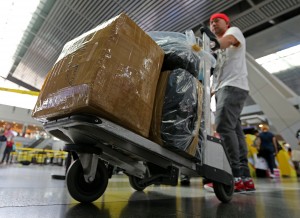
An OFW is seen with his luggage wrapped in plastic as protection from the “laglag-bala” or bullet-planting scam allegedly being done at the NAIA Terminal 3. INQUIRER PHOTO/RAFFY LERMA
MANILA, Philippines — To give passengers a chance to empty their bags of items banned in the airport and on airplanes, booths with disposal bins will be set up starting next week at the Ninoy Aquino International Airport (NAIA).
Two or three “last look” booths will be put up in each of the four NAIA terminals apart from the signage and TV monitors repeatedly playing English and Filipino reminders on prohibited items.
According to Vicente Guerzon Jr., senior assistant general manager of the Manila International Airport Authority (MIAA), the booths will be set up at the entrance queuing areas of the terminals. This would give passengers the opportunity to ditch items prohibited at the airport and on the aircraft before they pass through NAIA’s initial security screening checkpoints, Guerzon explained.
Guerzon said that boxes for SPI (security prohibited items) or simply disposal bins would be placed in each booth so passengers or even airport visitors could get rid of things, including bullets either used as talismans or souvenirs, that could cause their being detained or held for questioning by the police.
“The booths will afford passengers privacy so if they intend to dispose of something that might cause them embarrassment, they will be protected,” the MIAA official told the Philippine Daily Inquirer, adding that a passenger would not be questioned on the item he or she got rid of.
The setup of the booths, he said, would complement the MIAA’s enhanced awareness campaign on prohibited items. The airport authority will place large tarpaulin signage in all terminal entrances and install TV monitors explaining in detail and showing items that must not be placed in both handcarry and checked-in luggage.
“So before they go through the x-ray scanners, they are already made aware of the prohibited items. Knowing this, they can already use the ‘last look’ booths to get rid of whatever banned thing they have with them,” Guerzon explained.
The TV monitors will repeatedly show prohibited items and will have a voice over or writing in both English and Filipino “so it is easily understood.” Tarpaulin signage will also have English and Filipino versions.
“Another innovation is the setup at the NAIA of interrogation rooms with full audio and video recording so everything that is happening inside is transparent,” Guerzon told the Inquirer.
The interrogation rooms will be placed past the initial x-ray scanners so when a bullet is still found on a passenger’s baggage, even after all the reminders and the last look booths, the security cameras can prevent any “shady transaction.”
“Everything will be recorded so we can really prevent any possible extortion activity from happening. It will also discourage a bullet-carrier from making false claims or trying to bribe law enforcement agents,” he pointed out.
All these, Guerzon said, might be in place by next week in time for the Asia-Pacific Economic Cooperation Summit. SFM